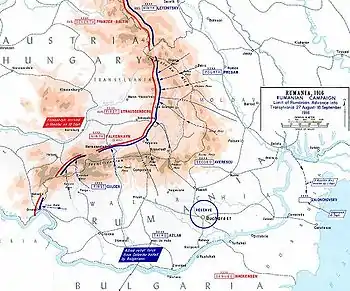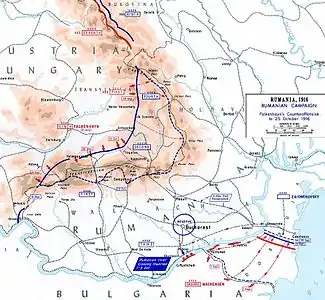9th Army (German Empire)
The 9th Army (German: 9. Armee / Armeeoberkommando 9 / A.O.K. 9) was an army level command of the German Army in World War I. It was formed in September 1914 in Breslau to command troops on the southern sector of the Eastern Front. The army was dissolved on 30 July 1916, but reformed in Transylvania on 6 September 1916 for the Romanian Campaign. It was transferred to the Western Front on 19 June 1918 where it was finally dissolved on 18 September 1918.[1]
| 9. Armee 9th Army | |
|---|---|
 Flag of the Staff of an Armee Oberkommando (1871–1918) | |
| Active | 19 September 1914 – 30 July 1916 6 September 1916 – 18 September 1918 |
| Country | |
| Type | Army |
| Engagements | World War I |
| Insignia | |
| Abbreviation | A.O.K. 9 |
History
First formation
The 9th Army Headquarters was established in Breslau on 19 September 1914 and commanded units drawn from the 8th Army, the Western Front and other units in Upper Silesia.[2] It was originally placed on the southern sector of the Eastern Front on the left flank of the 1st Austro-Hungarian Army.
| Organization of the 9th Army on 1 October 1914 | ||
|---|---|---|
| Army | Corps | Division |
| 9th Army Generaloberst Paul von Hindenburg |
XI Corps General der Infanterie Otto von Plüskow from 3rd Army, Western Front |
22nd Infantry Division |
| 38th Infantry Division | ||
| XVII Corps General der Kavallerie August von Mackensen from 8th Army |
35th Infantry Division | |
| 36th Infantry Division | ||
| XX Corps General der Infanterie Friedrich von Scholtz from 8th Army |
37th Infantry Division | |
| 41st Infantry Division | ||
| Guards Reserve Corps General der Artillerie Max von Gallwitz from 2nd Army, Western Front |
3rd Guards Infantry Division | |
| 1st Guards Reserve Division | ||
| Landwehr Corps General der Infanterie Remus von Woyrsch from 1st Austro-Hungarian Army[3] |
3rd Landwehr Division | |
| 4th Landwehr Division | ||
| III Cavalry Corps General der Kavallerie Rudolf Ritter von Frommel from Western Front |
8th Cavalry Division | |
| Under Army command | 35th Reserve Division in Fortress Thorn | |
| Landwehr Division Bredow in Posen[4] | ||
| 4 Landwehr Brigades | ||
| Fortresses at Posen, Breslau and Glogau | ||
Second formation
9th Army was reformed for the Romanian Campaign in September 1916. Along with the 1st Austro-Hungarian Army (1st A-H Army) it formed the Siebenburg Sector and had the following units:[5]
- XXXIX Reserve Corps
- Group von Szivo (A-H)
- Group Danube (A-H)
- 145th Infantry Brigade (A-H)
- Group Sunkel (A-H)
- 187th Division
- part of 144th Infantry Brigade (A-H)
- part of Alpenkorps[6]
- Group Krafft
- part of Alpenkorps
- Group von Szivo (A-H)
- Cavalry Corps "Schmettow"
- 51st Honvéd Infantry Division (A-H)
- 3rd Cavalry Division
- 1st Cavalry Division (A-H)
- En route
 Romanian invasion of Austria-Hungary, August 1916
Romanian invasion of Austria-Hungary, August 1916 Central Powers counterattack, September–October 1916
Central Powers counterattack, September–October 1916 Operations in Romania, November 1916 to January 1917
Operations in Romania, November 1916 to January 1917
Commanders
The original 9th Army had the following commanders until it was dissolved 30 July 1916:[7]
| From | Commander | Previously | Subsequently, |
|---|---|---|---|
| 18 September 1914 | Generaloberst Paul von Hindenburg | 8th Army | OB East[8] |
| 2 November 1914 | General der Kavallerie August von Mackensen | XVII Corps | 11th Army |
| 17 December 1914 | Generaloberst August von Mackensen | ||
| 17 April 1915 | General der Kavallerie Prince Leopold of Bavaria | Brought out of retirement | Heeresgruppe Leopold concurrently from 5 August 1915 |
A "new" 9th Army was formed in Transylvania for the Romanian Campaign on 6 September 1916. It was dissolved on the Western Front on 18 September 1918.[9]
| From | Commander | Previously | Subsequently, |
|---|---|---|---|
| 6 September 1916 | General der Infanterie Erich von Falkenhayn | Chief of the General Staff | Heeresgruppe F |
| 1 May 1917 | General der Infanterie Robert Kosch | 52nd Corps (z.b.V.) | 52nd Corps (z.b.V.) |
| 10 June 1917 | General der Infanterie Johannes von Eben | I Corps | Armee-Abteilung A |
| 9 June 1918 | General der Infanterie Fritz von Below | 2nd Army | [10] |
| 6 August 1918 | General der Infanterie Adolph von Carlowitz | XIX Corps | 2nd Army |
Glossary
- Armee-Abteilung or Army Detachment in the sense of "something detached from an Army". It is not under the command of an Army so is in itself a small Army.[11]
- Armee-Gruppe or Army Group in the sense of a group within an Army and under its command, generally formed as a temporary measure for a specific task.
- Heeresgruppe or Army Group in the sense of a number of armies under a single commander.
See also
- 9th Army (Wehrmacht) for the equivalent formation in World War II
- Great Retreat (Russian)
References
- Cron 2002, pp. 80–81
- Ellis & Cox 1993, p. 188
- Cron 2002, p. 52 Formed on mobilisation with 8th Army but detached in Upper Silesia. On 4 September 1914 came under the command of 1st Austro-Hungarian Army. Joined 9th Army on 24 September 1914.
- Cron 2002, pp. 101–102 Formed as a temporary division on 5 September 1914. Redesignated 18th Landwehr Division in December 1915.
- Ellis & Cox 1993, p. 194
- Despite its name, this was a division-sized formation.
- Cron 2002, p. 396
- Supreme Commander East (German: 'Oberbefehlshaber Ost')
- Cron 2002, p. 396
- The Prussian Machine Archived 4 December 2013 at the Wayback Machine Accessed: 5 February 2012 Below was nominally in command, but contracted pneumonia so von Eben remained in provisional command
- Cron 2002, p. 84
Bibliography
- Cron, Hermann (2002). Imperial German Army 1914–18: Organisation, Structure, Orders-of-Battle [first published: 1937]. Helion & Co. ISBN 1-874622-70-1.CS1 maint: ref=harv (link)
- Ellis, John; Cox, Michael (1993). The World War I Databook. Aurum Press Ltd. ISBN 1-85410-766-6.CS1 maint: ref=harv (link)